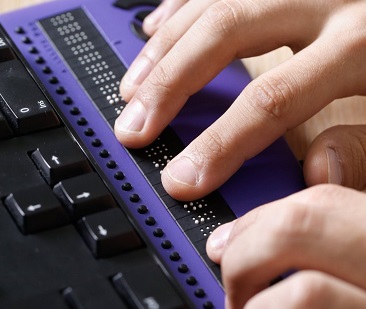How Much Do You Know About Making Documents Accessible?
by Beth
The Kennedy Center’s Office of Accessibility & Very Special Arts sponsored webinar met via Zoom free of charge at a time when I had another obligation. What a disappointment! The subject matter, “Creating Accessible Handouts” is something I am very interested in as a user (I am blind) and as a teacher who uses handouts in class sometimes.
People who know I am blind assume I know all the guidelines and HTML codes and tabs and things to use to make PDF documents and worksheets and other handouts accessible, but the truth is, I don’t!
I can tell you if my screen reader can read a document out loud to me, but I’m no expert at formatting a document or what codes to use to make them accessible, and the promotional information about the webinar made it sound like it was meant for me: intended for people who weren’t sure how to create a PDF that is screen reader accessible, people who wonder if they can include images in their handouts, and, if so, how and where to describe them. I checked in again a few days after the webinar and got some good news: they recorded it! The entire presentation is available for free on YouTube!
I listened to the webinar as soon as a could and right away in her introduction, Amber Pearcy, the presenter, tells her audience she was born blind. I was relieved to hear that – she’d know firsthand how frustrating it can be when handouts and forms are not accessible to screen readers.
She was smart to start the presentation by defining certain terms that she and I know well but may not be familiar to people outside of the disability world: things like “screen magnifier” and “speech recognition software” and “text to speech.” Along with explaining what a screen reader is, she turned up the audio on her own screen reader to demonstrate what it sounds like. Good idea!
From there, she let her audience know which programs she wasn’t fond of when it came to access. I found this part reassuring: it’s not just me! Amber has trouble with Google Docs, too, describing them as “too clumsy to even get in” using a speech synthesizer. She explained how it can be a little easier to access a link if that link is a stand-alone line rather than imbedded in a sentence. She used her mouse to click on an image to demonstrate how to add Alt text to an image. The hour was almost over by the time she got to discussing PDFs, acknowledging she could do an entire hour-long presentation on that task.
But with time running out, she pointed audience members to Adobe, who she says has quite a bit on their web site about making a PDF accessible. Amber described PDFs as the “most complicated and complex problem for blind people” when it comes to access. I totally agree.
It wasn’t until we got to this part that I finally realized: this webinar wasn’t intended for people who are blind, it was intended to show people who aren’t blind why and how certain things they do when creating handouts would make them more accessible for people who are blind or have visual impairments. Still, I am glad I checked the webinar out. Listening to the YouTube recording taught me what things are too complex and complicated to bother with, and to continue steering away from Google Docs and PDFs. Worth the price of admission for sure!







